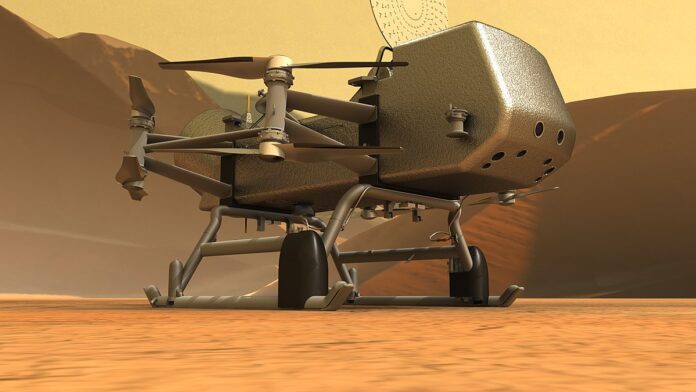I. Introduction
NASA’s pursuit of exploring Saturn’s moon Titan through the ambitious Dragonfly mission faces yet another delay, with the launch date pushed to July 2028. Despite successfully passing crucial design reviews, budget uncertainties force the space agency to postpone formal mission confirmation until a mid-2024 budget review. This article delves into the intricacies of the Dragonfly mission, unraveling the reasons behind the delay and examining the broader implications of financial constraints on NASA’s planetary science endeavors.
II. The Dragonfly Mission: A Chronicle of Delays
The Dragonfly Mission: A Chronicle of Delays
The Dragonfly mission, originally proposed in 2017 and selected for NASA’s prestigious New Frontiers program in 2019, has been marred by a series of delays, casting a shadow over its ambitious goal of exploring Saturn’s largest moon, Titan. This section delves into the chronological sequence of setbacks that have plagued the mission, unraveling the intricacies behind each delay.
1. Inception and Initial Projections
The Dragonfly mission, conceptualized in 2017, captured the imagination of scientists and space enthusiasts alike. With its groundbreaking rotorcraft-lander approach, Dragonfly aimed to conduct planetary exploration in a manner never attempted before. Selected for NASA’s New Frontiers program in 2019, the mission held the promise of unraveling the mysteries shrouding Titan’s environment and potential for life.
2. Initial Launch Projection: 2026
Anticipation surrounded the initial launch projection set for 2026. The mission, with its innovative design and scientific objectives, was on track to become a trailblazing chapter in planetary exploration. However, external budget pressures exerted their influence, foreshadowing the challenges that would later plague Dragonfly.
3. First Delay: Shift to 2027
The first blow to Dragonfly’s timeline came as a consequence of external budget pressures. In response to these fiscal challenges, NASA opted to push the mission’s launch to 2027. This delay, while disappointing, reflected the intricate dance between scientific aspirations and the financial constraints inherent in executing complex space missions.
4. Ongoing Fiscal Challenges: Shift to 2028
The saga of delays continued, with the latest announcement revealing a further shift in the launch date, this time to July 2028. The decision to postpone the mission, despite successfully passing key design reviews, underscores the persistent budget uncertainties plaguing NASA’s planetary science division.
5. Worrying Indecision: Formal Confirmation Deferred
Perhaps the most worrisome aspect of the latest delay is the space agency’s decision to defer formal confirmation of the Dragonfly mission until a mid-2024 budget review. This indecision introduces an additional layer of uncertainty, leaving the mission’s fate hanging in the balance until a clearer budget outlook emerges.
6. Impact on Exploration Goals
The chronicle of delays surrounding Dragonfly raises questions about the broader impact on NASA’s exploration goals. As the space agency grapples with fiscal challenges, the intricacies of confirming and executing missions become more pronounced. Dragonfly, designed as a pioneering venture into Titan’s unique environment, exemplifies the complex interplay between scientific ambitions and budgetary constraints.
7. Reflection on Budget Dynamics
The delays in the Dragonfly mission prompt a closer look at the budget dynamics within NASA’s planetary science division. The agency’s 2024 budget request for planetary science, standing at $3.38 billion, faces potential reductions based on proposed allocations in House and Senate bills. The resultant uncertainty makes confirming missions, including Dragonfly, a formidable challenge without a clear budget horizon.
III. Budget Uncertainties and NASA’s Dilemma
The primary catalyst for the mission’s delay revolves around the dynamic and uncertain funding landscape for NASA’s planetary science division. While the agency’s 2024 budget request for planetary science stands at $3.38 billion, proposed allocations in House and Senate bills indicate potential reductions, impacting not only Dragonfly but also other missions in NASA’s portfolio. Lori Glaze, director of NASA’s planetary science division, voiced concerns about confirming missions without a clear budget outlook. The critical question emerges: How can a mission be confirmed without a defined budget horizon? Glaze emphasizes the necessity of an “executable budget profile” for Dragonfly.
Glaze refrained from providing a specific cost estimate for the mission but acknowledged that it surpasses initial expectations. Speculation about reclassifying Dragonfly as a flagship mission, reserved for endeavors exceeding $1 billion, surfaces as its costs escalate. Flagship missions, including the Mars Perseverance rover and the James Webb Space Telescope, represent NASA’s most intricate and expensive projects. Glaze attributes the cost increase to a complex amalgamation of delays and other factors.
IV. Progress Amid Financial Hurdles
Despite grappling with financial challenges, the Dragonfly team achieved significant milestones. A NASA press release announced the mission’s success in meeting all criteria during the Preliminary Design Review earlier this year. Consequently, NASA authorized the mission to advance to its final design and fabrication phase, known as Phase C, scheduled for 2024. However, formal confirmation, encompassing the total cost and schedule, faces a delay until mid-2024, aligning with the release of the 2025 President’s budget request. This deferral raises concerns given that mission confirmation typically occurs at this juncture.
V. Dragonfly’s Unique Exploration Endeavor
Dragonfly, designed as a dual-quadcopter, presents an unprecedented opportunity to explore Titan’s distinctive environment. Titan, renowned for its dense atmosphere and surface liquids primarily composed of methane, captivates scientists as they aim to investigate its habitability, prebiotic chemistry progression, and potential for past life, whether water-based or hydrocarbon-based. The mission marks a pioneering moment as the first instance of utilizing a rotorcraft-lander for planetary exploration, distinct from the Ingenuity helicopter on Mars, which is not a lander.
In a NASA press release, Nicola Fox, associate administrator of NASA’s Science Mission Directorate, commended the team for overcoming technical and programmatic challenges. Fox expressed pride in the team’s ability to propel all facets of the mission toward confirmation despite the complexities involved.
VI. Budgetary Impact on NASA’s Exploration Landscape
Dragonfly is not the sole victim of NASA’s budget constraints. The Mars Sample Return mission faces a temporary hiatus pending further reviews, while the VERITAS mission to Venus experiences a “soft cancellation” due to similar financial challenges. These developments underscore the profound impact of budgetary limitations on NASA’s ambitious space exploration projects.
VII. Conclusion
As NASA navigates the delicate balance between scientific aspirations and fiscal realities, the Dragonfly mission stands as a symbol of resilience amid budget uncertainties. While delays pose challenges, the mission’s progress showcases the dedication and capability of the scientific community. The intricate dance between exploration goals and budgetary constraints continues, leaving the fate of Dragonfly and other missions hanging in the balance until the financial outlook becomes clearer in mid-2024.









